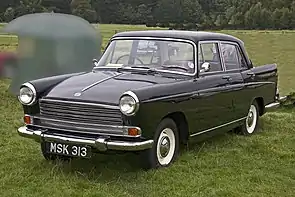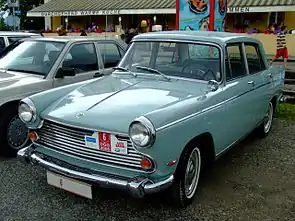| Morris Oxford Farina | |
|---|---|
.jpg.webp) Oxford Series VI Saloon 1963 | |
| Overview | |
| Manufacturer | Morris (British Motor Corporation, later British Leyland) |
| Production | 1959-1971 |
| Body and chassis | |
| Class | Family car |
The Morris Oxford Farina is a series of motor car models that were produced by Morris of the United Kingdom from 1959 to 1971.
Named by W R Morris after the city of dreaming spires, the university town in which he grew up, the manufacture of Morris's Oxford cars had helped to turn the south-side of Oxford into a thriving industrial area.
Like its predecessors, the Morris Oxford for the 1960s was a four-cylinder family car. It would have been seen as mid-sized in the UK, which is where most of the cars were sold. The Oxford (Farina) competed with models such as the Singer Gazelle and Vauxhall Victor.
Oxford series V 1959–61
| Oxford series V | |
|---|---|
 Oxford series V | |
| Overview | |
| Production | 1959–1961 87,432 produced[1] |
| Assembly | United Kingdom Australia [2] |
| Body and chassis | |
| Body style | 4-door saloon 4-door estate |
| Related | Austin A55 Cambridge Riley 4/68 MG Magnette III Wolseley 15/60 |
| Powertrain | |
| Engine | 1489 cc BMC B-Series engine Straight-4 |
| Dimensions | |
| Wheelbase | 99 in (2,500 mm)[3] 108 in (2,700 mm) |
| Length | 175.5 in (4,460 mm) [3] |
| Width | 63.5 in (1,610 mm) [3] |
| Chronology | |
| Predecessor | Morris Oxford series III |
| Successor | Morris Oxford series VI |
For 1959, the Oxford, announced on Lady Day 25 March 1959,[4] was merged into the mid-sized Pininfarina-designed BMC Farina range along with a half-dozen other previously announced models, including the 1958 Wolseley 15/60 and 1959 Riley 4/68, Austin A55 Cambridge Mark II, and MG Magnette Mark III. The Austin and Morris cars were nearly identical but were produced in separate factories. Differences in the Morris included some of the chrome and interior trim, and the rear lights. Inside, a front bench seat and special dashboard fitted with speedometer, oil pressure gauge, coolant temperature gauge, fuel gauge and clock (optional) were used. A choice of floor or column gear change was available. The handbrake was floor-mounted to the side of the seat. The 1.5 L B-Series engine continued. Drum brakes of 9 in (230 mm) diameter were fitted front and rear and the steering used a cam and peg system. The suspension was independent at the front using coil springs and had a live axle and semi-elliptic leaf springs at the rear.
Traveller
The Series IV Traveller was still listed till September 1960, by which time a Series V Traveller had been introduced.
Tested by The Motor magazine the car had a top speed of 78 mph (126 km/h) and could accelerate from 0–60 mph (97 km/h) in 25.4 seconds. A "touring" fuel consumption of 29.8 miles per imperial gallon (9.5 L/100 km; 24.8 mpg‑US) was recorded.[5]
Both standard and de-luxe versions were offered. The de-luxe package included a heater, manual screen washer, twin sun visors, twin horns, bumper over-riders, a clock and leather-covered seat. A two-tone paint scheme and a radio were available as options.[5]
On the home market the Standard version cost £815 and the de-luxe £844 including taxes.[5]
A Traveller estate car version of the Series V Farina body was announced 28 September 1960. The new body now provided a double bed size sleeping compartment about 6 ft long and 4 ft wide. The back of the car had a tail-board hinged at the bottom and an upper panel hinged at the top. The Morris version had a single bench front seat and cost £10 more than the equivalent Austin Countryman.[6]
In all, 87,432 Series V Oxfords were built.
 Oxford series V
Oxford series V Note the large tail fins of the original Farina series
Note the large tail fins of the original Farina series Detail of rear fins
Detail of rear fins
Oxford series VI 1961–71
| Oxford series VI | |
|---|---|
 Oxford series VI 1965 | |
| Overview | |
| Production | 1961–1971 208,823 produced[1] |
| Body and chassis | |
| Body style | 4-door saloon 4-door estate |
| Related | Austin A60 Cambridge Riley 4/72 |
| Powertrain | |
| Engine | 1622 cc BMC B-Series engine Straight-4 |
| Dimensions | |
| Wheelbase | 100 in (2,500 mm) [3] |
| Length | 174 in (4,400 mm) [3] |
| Width | 63.5 in (1,610 mm) [3] |
| Chronology | |
| Predecessor | Morris Oxford series V |
| Successor | Morris 1800 Morris Marina |
All five Farina cars were updated in October 1961[7] with a new 1.6 L (1622 cc/98 in3) version of the B-Series engine, longer wheelbase and a new revised look. The tail fins had been trimmed and there were still detail changes between the marques. The Morris retained the series V dash, while the Austin had an all-new fake woodgrain design.
Traveller
The Morris Oxford Traveller (estate) series V was replaced by a series VI, although little changed apart from the front grille.
Diesel
A diesel-engined Oxford series VI, introduced shortly after the 1961 update, was popular as a taxi. Variants of the same diesel engine enjoyed a long life in marine applications.
The Oxford VI remained in production until 1971 with 208,823 produced. The Oxford range was to have been replaced by the 1967 Morris 1800 (a badge-engineered 1964 ADO17 Austin 1800), but in the event both were built in parallel until 1971 because in terms both of pricing and of interior space the 1800 fell into the market segment of a slightly larger car. The ADO17 1800 continued until 1975, when it was succeeded by the Princess. The car that took the Oxford's place at the smaller end of the market segment was the Morris Marina, which also succeeded the yet smaller Minor.
 series VI saloon
series VI saloon Note the reduced tail fins for the saloon
Note the reduced tail fins for the saloon
 series VI Traveller
series VI Traveller Fins unchanged for series VI Traveller (estate) version
Fins unchanged for series VI Traveller (estate) version
References
Footnotes
- 1 2 Sedgwick, M.; Gillies, M. (1986). A-Z of Cars 1945–1970. Bay View Books. ISBN 1-870979-39-7.
- ↑ BMC-Leyland Australia Heritage Group, Building Cars in Australia, 2012, page 214
- 1 2 3 4 5 6 Culshaw; Horrobin (1974). Complete Catalogue of British Cars. London: Macmillan. ISBN 0-333-16689-2.
- ↑ New Morris Oxford. The Times, Wednesday, Mar 25, 1959; pg. 8; Issue 54418
- 1 2 3 "The Morris Oxford V Road Test". The Motor: 75–83. 4 May 1960.
- ↑ 'Double Bed' New Estate Cars. The Times, Wednesday, Sep 28, 1960; pg. 4; Issue 54888
- ↑ The British Motor Corporation. The Times, Wednesday, Oct 18, 1961; pg. 7; Issue 55215
Bibliography
- Davis, Pedr (1986). The Macquarie Dictionary of Motoring.